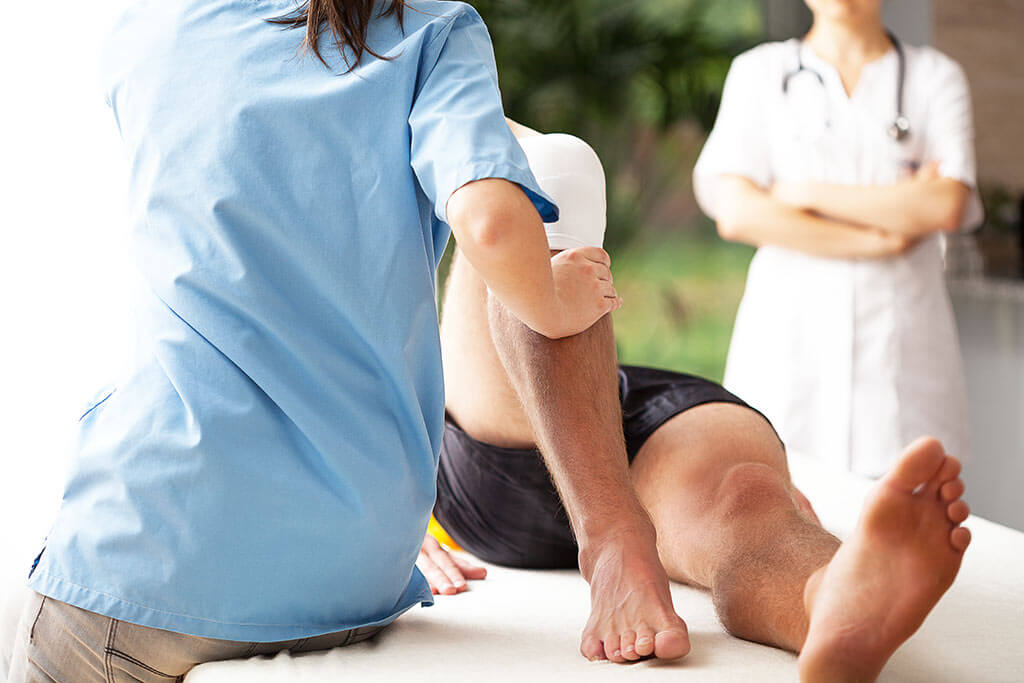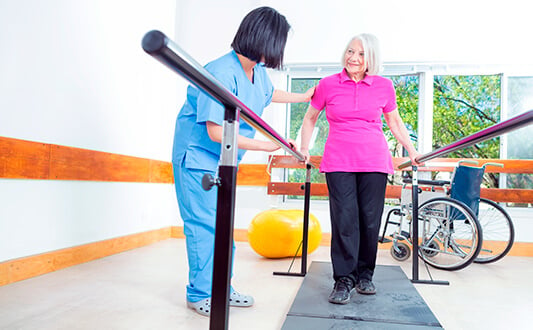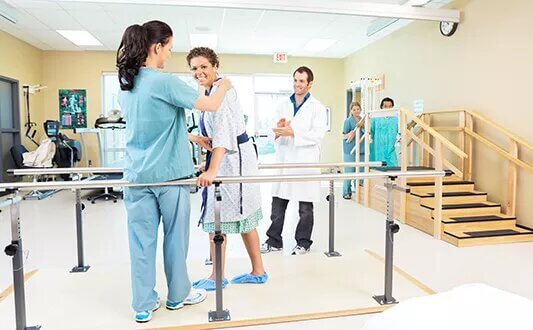Sports can involve spectacular competitions and fans often experience vivid emotions when watching them. They admire the skill and physical capabilities of athletes, often without thinking about the other side of the coin – active workout and the high risk of injury during training and performance. According to statistics, the average injury rate is 2.6 cases for every 1,000 hours of training.
German sports medicine physicians carry out specialized preventive examinations, create customized training programs to improve physical performance, and use minimally invasive treatment methods for sports injuries, as well as conducting rehabilitation programs that allow athletes to fully recover and return to their professional activities.
Content
- The objectives of sports medicine
- Upper limb injuries
- Lower limb injuries
- Back and spinal injuries
- Rehabilitation after sports injuries
- Treatment and rehabilitation in Germany with Booking Health
The objectives of sports medicine
Sports medicine in Germany is a multifaceted discipline with several objectives:
- Detection of risk factors in professional players and amateur athletes. These include asymptomatic cardiovascular diseases (for example, aneurysms or compensated heart valve defects), mild forms of diabetes mellitus, the early stages of bronchial asthma, and other pathologies. For example, 12% of participants in the 2010 Youth Olympic Games (YOG) were diagnosed with diseases requiring treatment. At the same time, only young people between the ages of 15 and 18 took part in the YOG.
- Assessment of the state of the cardiovascular system. For this purpose, resting and stress ECGs are performed (exercise on a stationary bike or a treadmill), as well as 24-hour blood pressure monitoring.
- Assessment of the state of the respiratory system. A chest X-ray and spirometry are carried out.
- Assessment of physical endurance, in particular, by the blood lactate level. To take part in marathons and sports that require prolonged physical activity, it is important not only to have a healthy initial state of cardiovascular and respiratory systems, but also their ability to work actively under monotonous and prolonged physical activity.
- Movement analysis. Thanks to video registration of movements, for example, when cycling or running, doctors can develop recommendations for optimizing movements, involving various muscle groups in the work, and correcting posture.
- Nutrition counseling. The diet is adapted to the specific sport and the intensity of physical activity. As a rule, athletes need a higher content of protein and micronutrients in their diet.
- Development of recovery programs after intense training and competition. These programs combine lighter physical activity, massage, and physiotherapy, as well as special nutrition. A full recovery reduces the risk of injury and improves a player's performance.
- Diagnostics of sports injuries and sports injury treatment. This is an extensive area of sports medicine that we will devote further sections of this article to.
The diagnostics of sports injuries in German sports medicine centers begin with a general examination – a consultation with a traumatologist, surgeon, neurologist, orthopedist, or another required specialist. The examination is followed by imaging testing: X-ray, ultrasound, CT, MRI, or angiography. Ultrasound scanning is often sufficient to assess the state of superficial soft tissues (for example, in cases of bruises). If more extensive damage is suspected, a tomography is performed – computed or magnetic resonance imaging. German clinics use tomographs with a high magnetic field strength, ranging from 3 Tesla.
Whenever required, doctors assess the condition of the nerve endings (electroneuromyography) and blood vessels (angiography). General laboratory tests and ECGs may also be conducted. The treatment methods for sports injuries vary significantly depending on the location and nature of the injury. We will discuss them below.
Upper limb injuries
Upper limb injuries can be either acute or caused by constant overloads of the same type. They are most often received by basketball players, bodybuilders, rowers, boxers, skiers, tennis players, golfers, and shot putters. Acute injuries include:
- fractures of the humerus, ulna, and radius;
- fractures of the wrist bones, metacarpus, and phalanges of the fingers;
- rotator cuff tear;
- soft tissue bruises, muscle tears;
- dislocations of various parts of the arm and hand.
Damages that develop due to constant intense physical activity include:
- "Tennis elbow" or "golfer's elbow" – in medical language, this pathology is called "epicondylitis"; it is caused by the inflammation of the tendons that attach the muscles of the forearm to the surface of the elbow joint
- "Skier's thumb" is a ligament tear in the thumb of the hand, due to intensive work with ski poles
- "Boxer's fracture" is damage to the joint capsules of the metacarpophalangeal joints and displacement of the tendons of the extensor muscles of the fingers, from constant intense punches
- Chronic shoulder instability is the protrusion of the humeral head from the anatomical capsule of the joint; often occurs when throwing a ball or putting a shot
Treatment of sports injuries of the shoulder begin with immobilization and anesthesia – a fixing or an immobilizing bandage is applied to the shoulder, and nonsteroidal anti-inflammatory drugs are prescribed. In cases of dislocations, the doctor preliminarily sets the displaced part of the humerus. If there is a need for surgical treatment, then German orthopedic traumatologists perform the surgical repositioning of bones or arthroscopic repair of internal structures of the joint or the capsular ligamentous apparatus. Fractures can also be treated surgically. In complex cases, total or partial shoulder replacement surgery is performed.
Elbow sports injury treatments also begin with restoring the normal anatomical position of the bones (in cases of dislocations and fractures), immobilization with a plaster cast or orthosis, and pain management. As a minimally invasive treatment, PRP therapy is used, which involves the injection of the patient's own platelet-rich plasma into the joint. In cases of muscle injuries, or tendon and ligament injuries, a minimally invasive (arthroscopic) treatment is performed, up to the point of replacing the tendon or ligament with an artificial prosthesis. With severe elbow joint injuries, total or partial replacement surgery is performed. Doctors also pay attention to the condition of the ulnar nerve, which runs along the inner side of the elbow joint and innervates the forearm and hand. Whenever required, surgical decompression of the ulnar nerve canal is performed during surgery, or independently of it.
Lower limb injuries
Football, volleyball and basketball players, runners, and skiers suffer most often from sports injuries of the lower limbs. As with the arm and hand, sports injuries of the hip, lower leg, and foot can be either acute or chronic. To prevent lower limb injuries, the proper selection of shoes, warming up before intense loads, and the correct distribution of loads during training are important.
The most common acute lower limb injuries are:
- sprained ankle, occurring when landing unsuccessfully after a jump;
- tearing of the anterior or posterior cruciate ligament of the knee is most common in football players and martial arts participants;
- knee meniscus tears are most common in soccer players;
- thigh, lower leg, and foot bone fractures.
Chronic injuries include:
- "Runner's knee" develops with the increased friction of the patella against the femur and inflammation of the ligamentous apparatus due to this impairment; in addition to runners, the pathology is most common in step aerobics and in swimmers
- Achilles tendinitis develops after using the wrong choice of shoes for training or leaving inadequate recovery periods between workouts; the pathology is often caused by running or jumping
- Medial tibial stress syndrome is an inflammation of the periosteum and tibial deformation from repetitive stress and trauma; manifested by pain along the inner surface of the lower leg
- "Fatigue fractures" are bone microfractures that appear when the intensity of the load increases too quickly; without proper adjustment of the training regimen, they lead to full-fledged bone fractures
In closed hip joint injuries, orthopedic traumatologists recommend starting with functional rest, immobilization, injection pain management, and physiotherapy. PRP therapy and Orthokine therapy also ensure good results: in both types of treatment, the athlete's own blood is used, from which, biologically active substances are obtained. The next stage is arthroscopic interventions to restore the articular cartilage, synovium, or ligamentous apparatus. If a more complete restoration of the joint is required, German surgeons perform total or superficial (according to McMinn) joint replacement surgery. Superficial joint replacement surgery is only offered by a limited number of clinics; among its advantages is the opportunity to return to professional sports.
Surgical treatments for sports injuries of the knee include the restoration of the patella, ligamentous apparatus, menisci, and bone structures of the joint:
- Blount's patellar surgery – the doctor corrects the position of the displaced patella, which prevents the development of arthrosis in the future.
- Knee ligament rupture treatment in Germany begins with conservative methods (immobilization and pain management). Nonetheless, over 90% of athletes undergo surgery to fully restore knee function. During the surgery, the patient's own ligamentous apparatus is reconstructed or partially replaced with artificial ligament prostheses.
- Meniscus tear treatment in Germany is carried out arthroscopically – the doctor performs all the manipulations through three small punctures, without opening the joint cavity. Meniscus reconstruction surgery in Germany can include the resection of the destroyed part of the meniscus or its suturing. With total destruction, the meniscus is replaced with a biological or synthetic prosthesis.
- Autologous cartilage transplantation – the patient's own pre-harvested and processed stem cells capable of forming cartilage tissue on the surface of the joint are transplanted.
- Partial knee replacement surgery, according to Repicci technique – the surgeon replaces one of the two femoral condyles, thereby reducing the trauma of the operation, therefore, the patient can even lean on the leg the day after the surgical procedure.
Ankle fracture treatment in Germany begins with immobilization for 4-8 weeks. Doctors use splints and bandages that immobilize the joint and, at the same time, prevent muscle atrophy due to prolonged immobility. If the fracture contains a bone displacement, the doctor accurately compares the fragments and, if necessary, fixes them with a screw or a knitting needle. In cases of open fractures or ligament injuries between the tibia and fibula, German doctors always perform surgical treatment.
Back and spinal injuries
A sports back injury is considered the most dangerous type of trauma because it can damage the spine and spinal cord. In the treatment of such injuries, prevention of disability and restoration of mobility/sensitivity come first; only after this do the doctors consider starting vocational rehabilitation for the resumption of sports activities.
The risk group includes motorcycle riders, gymnasts, and divers. Sports back injuries can be:
- penetrating (with skin lesions) and non-penetrating;
- with damage to the cervical, thoracic, lumbar, or sacrococcygeal spine;
- with or without a spinal cord injury;
- acute or chronic.
The mildest type of sports back injury is a spinal muscle and ligament sprain. The problem is solved by wearing a corset or bandage, switching to a more sparing training regimen, going to physiotherapy, and taking painkillers. Doctors in German medical centers make this diagnosis only after comprehensive diagnostics to exclude more serious pathologies.
Spinal injuries include spondylolysis (a defect in the vertebral arch), spondylolisthesis (an extensive defect in the vertebral arch with the spinal column slipping forward), a vertebral fracture (teared or compressive), and spinal disc herniation. Spinal injuries are treated with surgery; if possible, doctors use endoscopic techniques, whilst maintaining the integrity of the paravertebral soft tissues. In spondylolisthesis, doctors use transpedicular systems to fix the displaced vertebrae into the proper anatomical position. In cases of spinal disc herniation, damaged discs are resected, reduced in size using an electric probe, filled with hydrogel, or replaced with prostheses. The damaged vertebral bodies are filled with special bone cement. When providing treatment, German doctors pay due attention to assessing the state of the spinal cord – this is important for maintaining mobility, sensitivity, pelvic organ functioning, and erection in men.
Spinal cord and nerve ending injuries require the involvement of neurosurgeons and neurologists in the therapeutic process. First of all, specialists restore the integrity of the spine, relieve pressure on the spinal cord, and take care of the normal movement of the cerebrospinal fluid. In addition, pharmacological support is carried out: patients receive medications to improve their cerebral circulation and also metabolic drugs. It is possible to undergo modern stem cell therapy in special German clinics. Only this type of treatment can restore dead neurons.
Rehabilitation after sports injuries
Depending on the type of sports injury, rehabilitation is aimed at restoring the normal range of motion in the joints and muscle tone, the ability to walk and run, sensitivity, and other functions. Doctors in specialized German centers begin rehabilitation as early as possible – this allows the patients to avoid muscle atrophy and the formation of pathological motor stereotypes.
Rehabilitation programs include exercises with the use of locomotor and robot-assisted devices (for example, Lokomat and Erigo), training using virtual reality, transcranial magnetic stimulation, electrical stimulation, reflexology, massage, lymphatic drainage, kinesiotherapy, physiotherapy, and stem cell therapy. Whenever required, rehabilitation therapists use other techniques. The procedures and duration of the program are determined for each athlete individually.
The following medical facilities specialize in orthopedic rehabilitation after the completion of the main treatment course:
- Dr. Franz Dengler Clinic Baden-Baden, Department of Orthopedic Rehabilitation
- MEDIAN Rehabilitation Clinic Bernkastel-Kues, Department of Orthopedic Rehabilitation
- MEDIAN Rehabilitation Clinic Wismar, Department of Orthopedic Rehabilitation
The following medical facilities specialize in rehabilitation after spinal cord injuries:
- Neurological Rehabilitation Clinic Godeshöhe Bonn, Department of Spinal Injury
- St. Mauritius Therapieklinik Meerbusch, Department of Neurology
The following medical facilities specialize in outpatient neurological rehabilitation:
- Outpatient Rehabilitation Clinic Berlin, Department of Outpatient Neurological Rehabilitation
- St. Antonius Hospital Eschweiler, Department of Orthopedic, Cardiac and Neurological Rehabilitation
- Outpatient Rehabilitation Clinic Frankfurt am Main, Department of Outpatient Neurological Rehabilitation
The average cost of orthopedic rehabilitation is €461 per day, rehabilitation of spinal trauma – €1,674 per day, and outpatient neurological rehabilitation – €440 per day.
Treatment and rehabilitation in Germany with Booking Health
To avoid travel-related difficulties and make treatment abroad more affordable, please contact the Booking Health company. Booking Health is a medical tourism agent that has been organizing the treatment and rehabilitation of athletes from 75 countries, in specialized medical centers, for over 15 years.
Based on the annual qualification reports of medical facilities and their own experiences, the Booking Health specialists will help you to select the best clinic for treatment and rehabilitation after a sports injury. The leading rehabilitation centers have already been presented above. The leaders in sports injury treatment in Germany are:
- HELIOS Clinic Krefeld, Department of Adult and Pediatric Orthopedics, Traumatology and Hand Surgery
- Hospital Neuwerk Moenchengladbach, Department of Adult and Pediatric Orthopedics, Traumatology
- Catholic Clinic Koblenz-Montabaur, Department of Adult and Pediatric Orthopedics, Traumatology, Endoprosthetics
- Academic Hospital Brothers of Mercy Munich, Department of Orthopedics and Traumatology
- Academic Municipal Hospital Karlsruhe, Department of Adult and Pediatric Traumatology, Hand and Orthopedic Surgery
Booking Health will also help you with the following issues:
- selection of the most suitable treatment option or rehabilitation program;
- booking an appointment on the most suitable dates;
- preliminary calculation of the cost of your medical care program;
- provision of medical services at an affordable price, without additional coefficients for foreign patients (save up to 50%);
- buying drugs and medical supplies to continue your treatment in your native country;
- keeping in touch with the attending physician and the clinic upon the completion of your treatment;
- control of invoices and return of unspent funds to your bank account;
- organization of additional examinations, if necessary;
- organization of your trip: booking a hotel or apartment for outpatient treatment, buying airline tickets, interpreter services, etc.
The independent doctors of the Booking Health company will take care of every stage of your treatment or rehabilitation. During your stay abroad, your personal medical coordinator will keep in touch with you at all times.
Please indicate your diagnosis and your contact number on the "send request" form, and our medical advisor will contact you the same day to plan your further actions.
Choose treatment abroad and you will for sure get the best results!
Authors:
The article was edited by medical experts, board certified doctors Dr. Nadezhda Ivanisova and Dr. Vadim Zhiliuk. For the treatment of the conditions referred to in the article, you must consult a doctor; the information in the article is not intended for self-medication!
Sources:
National Center for Biotechnology
Read:
Why Booking Health - questions and answers
How to make right decision when choosing the clinic and specialist
7 reasons to trust to the rating of clinics on the Booking Health portal
Don't know where to start?
Contact Booking Health







